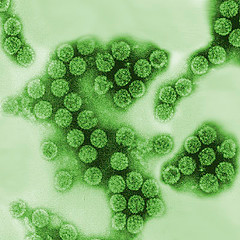16/04/2015
Presença de Polyomavirus em indivíduos saudáveis

Por Tatiana F. Robaina,Gabriella S. Mendes,Fabrıcio J. Benati,Giselle A. Pena, Raquel C. Silva, Miguel A.R. Montes,Maria Elisa R. Janini,Fernando P. Câmara e Norma Santos.
Este estudo é o resultado de uma colaboração entre o Instituto de Microbiologia e a escola de Odontologia, Universidade Federal do Rio de Janeiro. Através de analises por PCR foi detectada a presença de polyomavirus na saliva de indivíduos saudáveis. Das 291 amostras testadas 71(24.3%) foram positivas pra pelo menos um dos polyomavirus testados.
A detecção foi mais alta, principalmente, em indivíduos com 15-19 anos de idade (46.0%; 23/50) e em uma escala menor em pessoas com 50 anos de idade (33.3%; 9/27). Estes resultados reforçam a hipótese de que a saliva pode ser uma via para a transmissão do BKV e que a cavidade oral pode ser um sitio de replicação viral. Outros polyomavirus podem ser transmitidos de modo similar.
Shedding of Polyomavirus in the Saliva of Immunocompetent Individuals
The aim of this study was to investigate and compare the frequency of BKV, JCV, WUV, andKIV in the saliva of healthy individuals. Samples were analyzed for the presence of polyomaviruses (BKV, JCV, WUV, and KIV) DNA byreal-time PCR. Of the 291 samples tested, 71 (24.3%) were positive for at least one of the screened polyomaviruses. Specifically, 12.7% (37/291) were positive for WUV, 7.2% (21/291) positive for BKV, 2.4% (7/291) positive for KIV, and 0.3% (1/291) positive for JCV. BKV and WUV co-infections were detected in 1.7% (5/291) of individuals. No other co-infection combinations were found. The mean number of DNA copies was high, particularly for WUV and BKV, indicating active replication of these viruses. Polyomavirus detection was higher among individuals 15–19 years of age (46.0%; 23/50) and 50 years of age (33.3%; 9/27). However, the detection rate in the first group was almost 1.7 % greater than the latter. WUV infections were more frequent in individuals between the ages of 15 and 19 years and the incidence decreased with age. By contrast, BKV excretion peaked and persisted during the third decade of life and KIV infections were detected more commonly in subjects 50 years old. These findings reinforced the previous hypotheses that saliva may be a route for BKV transmission, and that the oral cavity could be a site of virus replication. These data also demonstrated that JCV, WUV, and KIV may be transmitted in a similar fashion.
J. Med. Virol. 85:144–148,2013.


